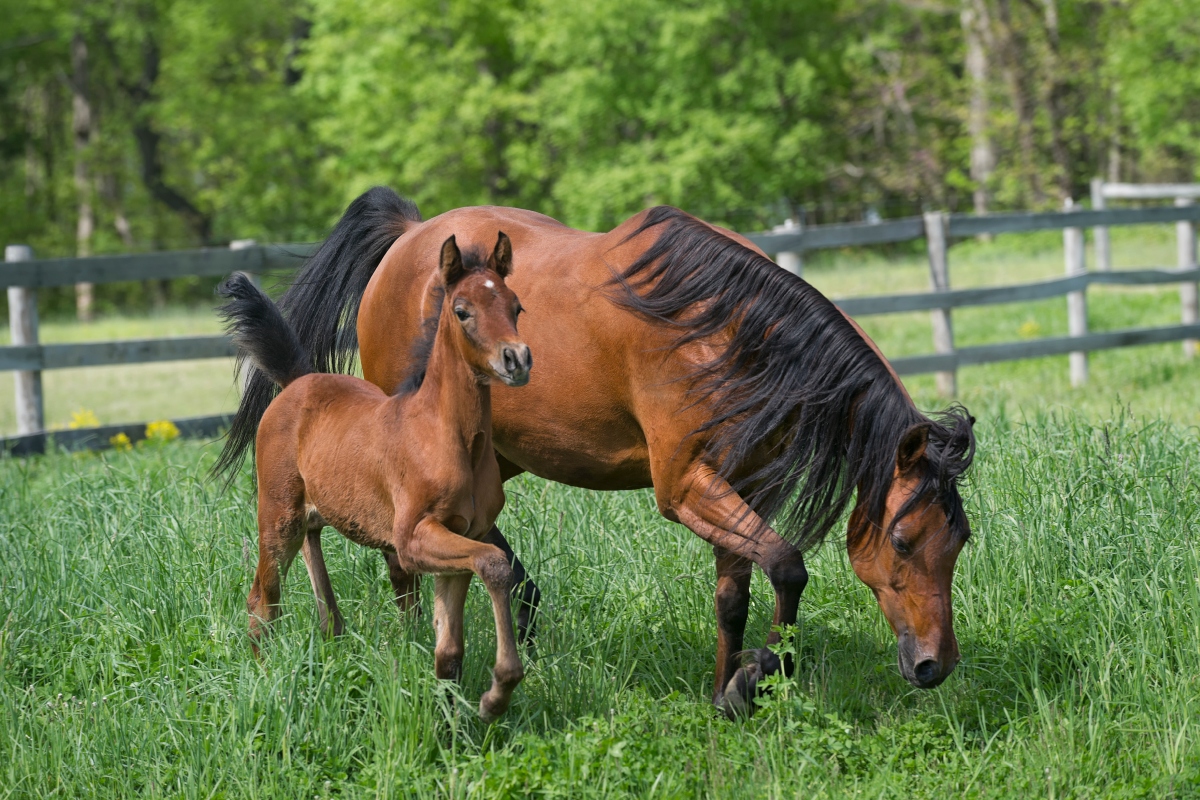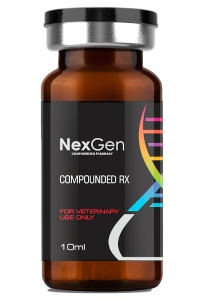What Size Follicle Do Mares Ovulate?

The ovarian follicle is a fluid-filled sac surrounded by a group of cells that protect and nourish the ovum (egg). There are thousands of follicles in a mare’s ovaries, but usually only one begins to develop during each estrous cycle.1 By Day 16 of the mare's cycle, the developing follicle has reached the size at which it secretes enough hormone to bring on the external characteristics of heat.
As a dominant follicle forms, it produces inhibin and suppresses the growth of other follicles in the ovaries. It is at this point that we see the "starburst" on the uterine cross section. (Figure above, right). Although starburst is often associated with the first ovulation of the season, it is not an infallible indicator that the first ovulation is about to occur.2
Criteria and Continuity
In mares, follicles typically ovulate at diameters of between 35 and 55 mm. It is important however, to establish baselines for the ongoing measurement of mares' follicles within a breeding program, as well as continuity in determining related measurements. The available literature suggests criteria such as the following for full-sized horses and ponies:
- Follicular diameter must be determined by averaging the widest and narrowest parts visible per ultrasound. Variations between the two are likely, meaning that palpation alone will tend to result in less accurate diameter estimations
- Most mares are less likely to ovulate with a follicle that is smaller than 35 mm
- Double ovulations with follicles on the same ovary are likely to occur with smaller diameter follicles - possibly less than 35 mm
- Follicular growth is approximately 3-5 (three to five) mm per day
- Uterine edema - an important indicator of estrus - peaks around 36 hours prior to ovulation in healthy mares. Mares that have edema that persists closer to or after ovulation are more likely to have delayed uterine clearance issues
- A change in regularity of follicular shape visible per ultrasound - with a tendency towards a "teardrop" or "guitar pick" shape - is likely to be seen within the 24 hours prior to ovulation in about 85% of preovulatory follicles
- A thickening of the follicular wall visible per ultrasound - evidenced by a thicker white line surrounding the follicle (especially visible on the lower margin) - is likely to be seen within 24 hours prior to ovulation in about 85% of preovulatory follicles
- Ovarian sensitivity to touch upon palpation per rectum may be demonstrated within the 12 hours prior to ovulation in some mares (make sure you differentiate this from the mare that is always sensitive upon palpation. The "ovarian sensitivity" marker refers only to mares that have a change in response)
- Most follicles will become softer upon palpation per rectum within 6-12 hours prior to ovulation. While more easily identified by palpation, application of slight pressure with the rectal probe of an ultrasound that results in a flattening of the upper surface of the follicular image may also be indicative of follicular softening
- Most follicles will reduce slightly in average diameter at some point during the 6 hours prior to ovulation
- There may be slight evidence of white specks in the follicular fluid within the 12 hours prior to ovulation, which should not be confused with indications of an anovulatory hemorrhagic follicle
- A visible "leaking" of the follicular fluid outside the main portion of the follicle per ultrasound is indicative of immediately impending or ongoing ovulation2
Size and Maturation
At approximately Day 20, the follicle reaches its full size of between 35mm and 55mm and ruptures, releasing the egg into the fallopian tube (ovulation). The ruptured follicle forms the corpus luteum, which secretes the hormones that prepare the uterus for pregnancy. After ovulation, the egg survives in the fallopian tube where it survives for up to 12 hours and must be fertilized by a sperm within that time if pregnancy is to be achieved.1
Ideally, the mare is bred a few hours before ovulation so that the sperm will be already in the fallopian tube when the egg is released. Knowing precisely when a mare is ready to ovulate is essential in an effective breeding program: 50% of mares ovulate 24 hours before the end of heat, with 30% ovulating 48 hours before the end of heat. Some mares may come into heat but do not ovulate, while others ovulate without showing obvious signs of heat.
Other Factors
 A
65% conception (pregnancy) rate is considered average for a horse breeding
farm. Unfortunately, this means that 35% of all the mares bred are left open
until the following breeding season.3 Other factors which can affect
follicle development and fertility in general include age (there is an expected
decline in fertility beginning at 12 years of age), environment and diet.
A
65% conception (pregnancy) rate is considered average for a horse breeding
farm. Unfortunately, this means that 35% of all the mares bred are left open
until the following breeding season.3 Other factors which can affect
follicle development and fertility in general include age (there is an expected
decline in fertility beginning at 12 years of age), environment and diet.
For mares, rectal palpation by a veterinarian provides critical information regarding the condition of the reproductive tract, and can confirm the presence of a follicle. Further testing, including uterine ultrasound, uterine biopsy, and cultures may be recommended. Finally, the conformation of the vulva should be periodically evaluated to determine if the mare is susceptible to uterine infections, which become more likely as the mare ages.
Equine Breeding Products
You can find equine breeding products in our online store. Login to your account to view prices and purchase or create an account. Please note you must have a valid veterinarian license to create an account. If you do not, please forward our information to your veterinarian.
1Huntington,
P., DVM. Follicle Development and Ovulation in Mares, equinews.com, 2014.
2equine-reproduction.com.
3myhorseuniversity.com.
About NexGen Pharmaceuticals
NexGen Pharmaceuticals is an industry-leading veterinary compounding pharmacy, offering sterile and non-sterile compounding services nationwide. Unlike other veterinary compounding pharmacies, NexGen focuses on drugs that are difficult to find or are no longer available due to manufacturer discontinuance or have yet to be offered commercially for veterinary applications, but which still serve a critical need for our customers. We also specialize in wildlife pharmaceuticals, including sedatives and their antagonists, offering many unique options to serve a wide array of zoo animal and wildlife immobilization and anesthesia requirements.
Our pharmacists are also encouraged to develop strong working relationships with our veterinarians in order to better care for veterinary patients. Such relationships foster an ever-increasing knowledge base upon which pharmacists and veterinarians can draw, making both significantly more effective in their professional roles.



